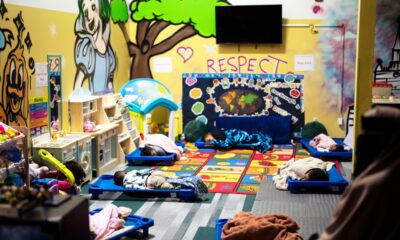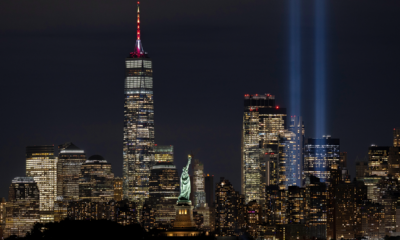Lifestyle
She turned an empty L.A. lot into a gorgeous mini flower farm as a 'win-win'

Kathleen Ferguson grabbed a pair of pruning shears from a mailbox nailed to a garden bed and leaned down to cut bunches of Orlaya grandiflora on the flower-filled hillside.
“This property has a pulse,” she said as she placed the white lace flowers into a bucket of water. “The wildlife is incredible here. I’ve caught bees napping in the sunflowers.”
With limited land for green space in Los Angeles, many people are growing flowers for sale in surprising places — under power lines and in their front and backyards. In Ferguson’s case, the landscape designer is propagating flowers on a vacant lot offered by a friend, screenwriter Dalan Musson, whom she met while volunteering at the North Central Animal Shelter in L.A.
The vacant hillside, before Kathleen Ferguson transformed it into a flower garden.
(Kathleen Ferguson)
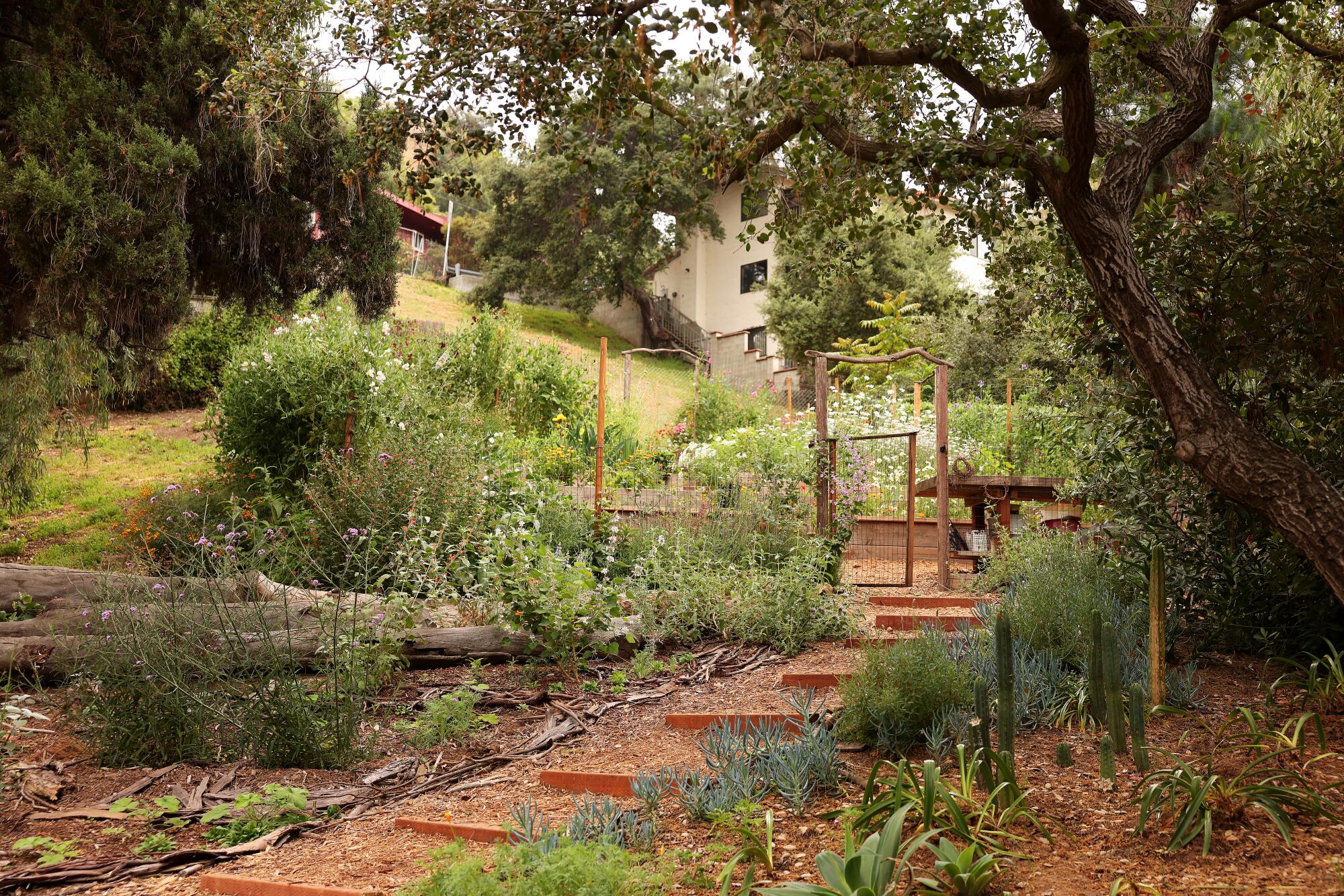
Ferguson’s lush garden now.
“Just being able to walk outside and see monarch butterflies and bees flying around my backyard is amazing,” Musson said of Frogtown Flora’s effect on the wildlife on his 1.5-acre property in Eagle Rock. “It makes me feel viscerally connected to the natural world.”
It’s magical for Ferguson too, who over the last 11 months has built a colorful farm on the half-acre with flowers, including Agrostemma, irises, zinnias, cosmos, roses, sunflowers, sweet peas, French dianthus and ranunculus. White marigolds and green onions are planted to help deter the skunks, raccoons and squirrels that like to pull out her dahlias. Volunteer tomatoes and cilantro that materialized from the compost are left to bolt and blossom. “I like to mix it up,” she said of the variety of plant life. “If something comes up, I’m OK with letting it grow.”
Outside the farm’s perimeter and at the top of the hillside, she is experimenting with drought-tolerant California native perennials, including fragrant pitcher sage, buckwheat, mallows and the native rose, Rosa Californica. She also grows native poppies — Matilija and California — penstemons, lupines and many different salvias.
Like many landscape designers used to working outdoors, Ferguson struggled with cabin fever during the COVID-19 pandemic. When she began listening to podcasts about locally grown blooms while tending to her own garden, she became “obsessed with flowers.”
“I would listen to podcasts all day long: ‘On Being,’ ‘Slow Flowers,’ ‘Cultivating Place’ and [‘Field & Garden’ from the Gardener’s Workshop] among them,” she said. She was struck by the environmental effect of imported flowers regarding pesticides, water and shipping, and her journey into urban flower farming was a natural progression. With a degree in horticulture from Cal Poly Pomona and a passion for the environment, she decided to grow what she describes as “climate-appropriate flower species” for Los Angeles.
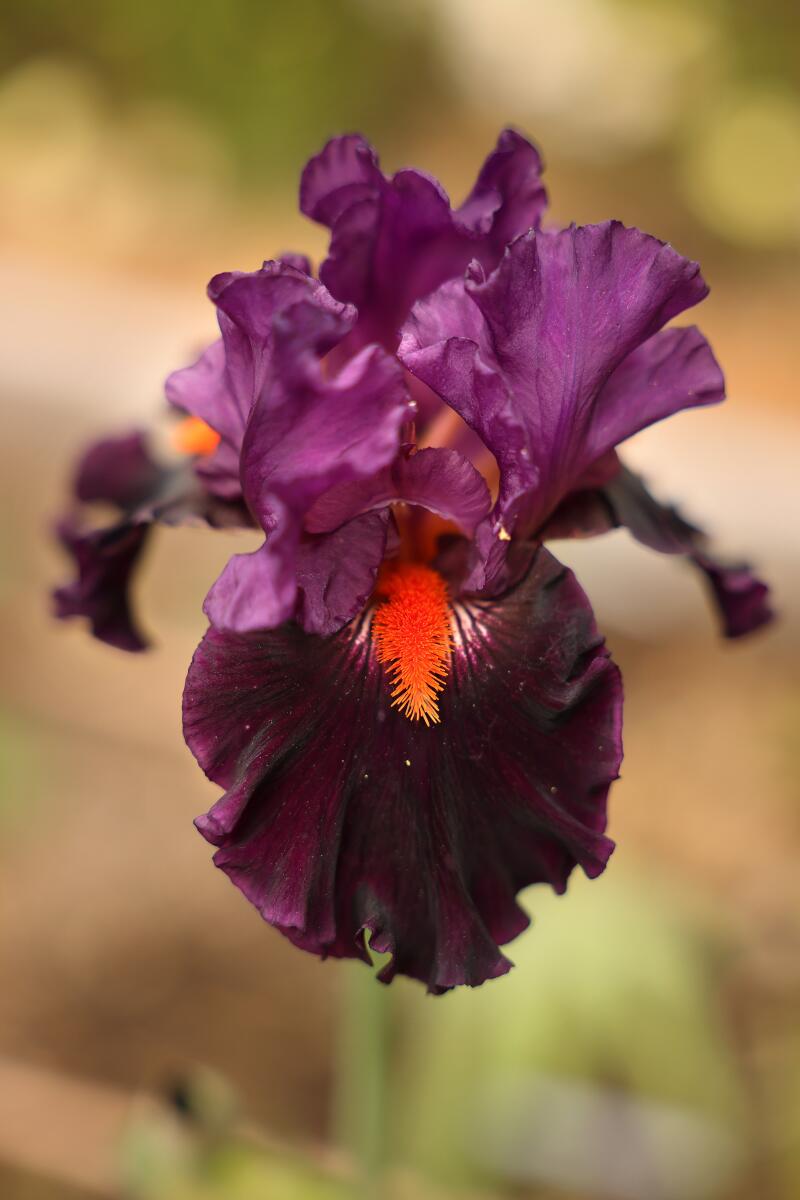
A Sharp Dressed Man iris in Ferguson’s garden.

Ferguson tends to her flowers.
She learned a lot from the local flower growers she contacted on Instagram: “I noticed that all of the flower farmers, who happened to be women, are so passionate about what they do and so generous with their knowledge. I can reach out to any of them and ask, ‘What has been your experience with germination?’”
The flower growers hosted rotating potlucks at their farms and attended the San Fernando Valley Iris Society, of which Ferguson is a member.
Her first venture was a small plot at Jardin del Rio on Riverdale Avenue in 2022. But as her interest and knowledge grew, so did her ambitions. When Musson listened to how passionate she was about growing flowers locally, he offered a portion of his property as a new canvas for her urban flower farm.
“People are good,” Ferguson said of Musson. “People are generous; they want to help others realize their dreams. It’s a win-win for both of us.”
The challenge for Ferguson was the site. “I was excited,” she recalled, “but when I saw it was a slope, I knew it would be a lot of work.”
Once she understood how it might work, she built 12 four- by 10-foot raised beds on either side of a stairway with wood leftover from a construction project.
“My husband and I loaded the wood in a truck and brought it here,” she said. “Now, when I get extra wood, I can’t help but think about what I can grow here. We’re going to put in a greenhouse and add more beds. Everyone my age is into pilates and strength training, and when they suggest I go, I tell them, ‘Do you know how much strength training I do on this slope?’”
Ferguson’s good luck continued when she realized the soil didn’t need a lot of work because the land had never been developed. “We used what was here,” said the designer and certified arborist, who avoids chemicals. She started with a weed barrier, on-site soil, worm castings, compost and organic fertilizer. She tops the soil with her rabbits’ bedding when it’s time for it to be replaced and has been experimenting with sheep pellets to enrich the soil and help deter slugs, snails and weeds. She installed a drip irrigation system and pays Musson monthly for water, although she said she doesn’t use it much. “The natives don’t require any once established,” she added.
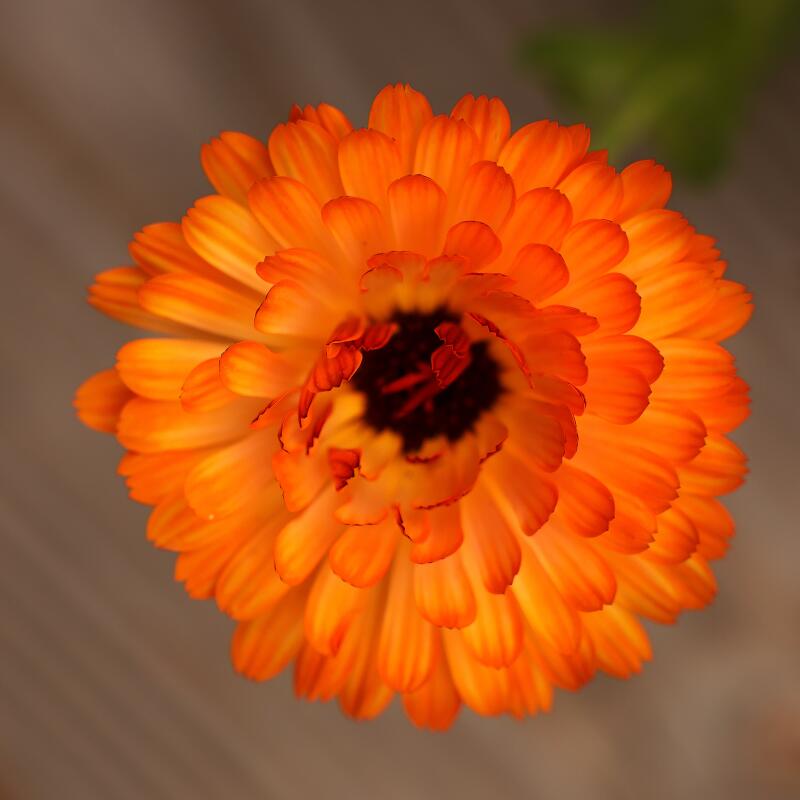
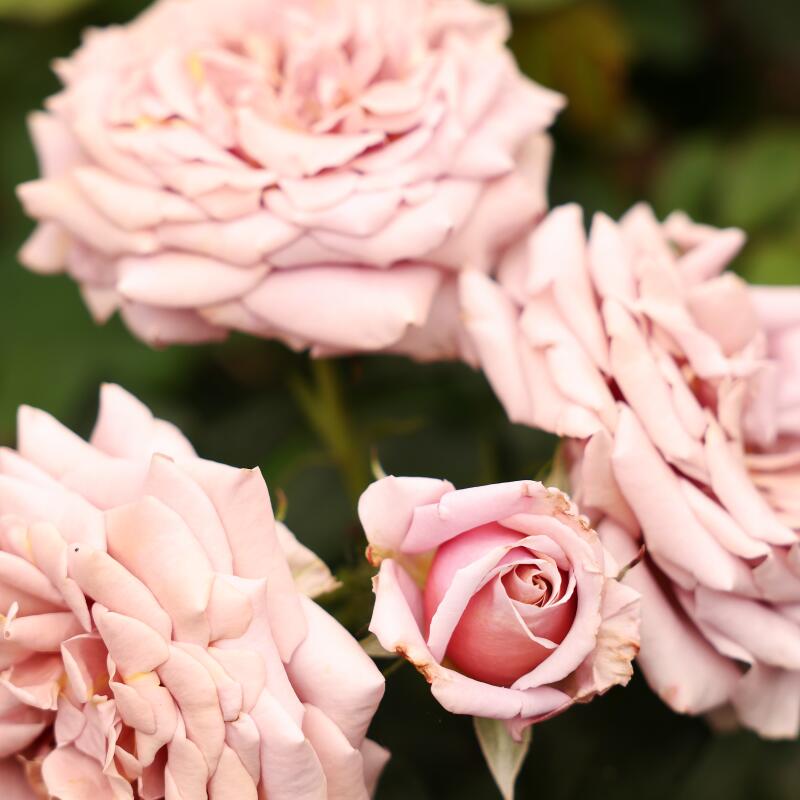

Calendula. Koko Loco roses. Penstemon.
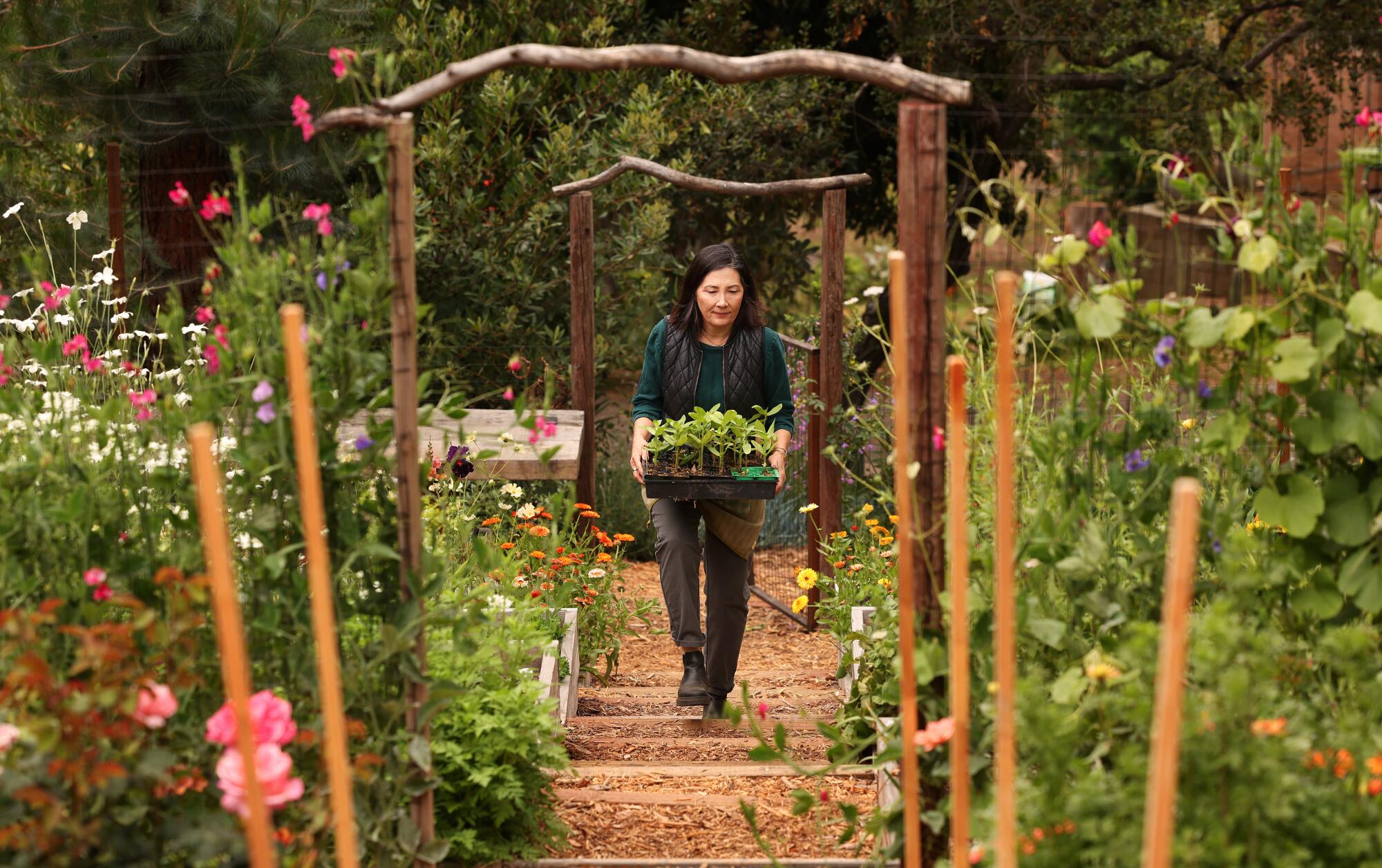
Ferguson carries zinnias she grew from seeds up the stairs of her hillside garden.
She is a big fan of using rabbit waste as fertilizer because it doesn’t require composting like chicken manure.
“Rabbit poop is amazing and so good if you are trying to close the loop in your garden,” she says, “as you can feed them a lot of greens, and then what they produce goes straight into the garden.”
While some farmers choose what is trendy, Ferguson prefers to plant flowers she likes. It’s a strategy that is working.
“Kathleen’s flowers are dazzling,” said Lauri Kranz, who sells Ferguson’s flowers at L.A. Homefarm in Highland Park. “When Kathleen pulls up in her car with buckets full of just cut flowers, our customers start making a line to pull from the bounty that awaits.”
For Ferguson, a Los Angeles native who grew up in Koreatown, flowers are about more than just beauty.
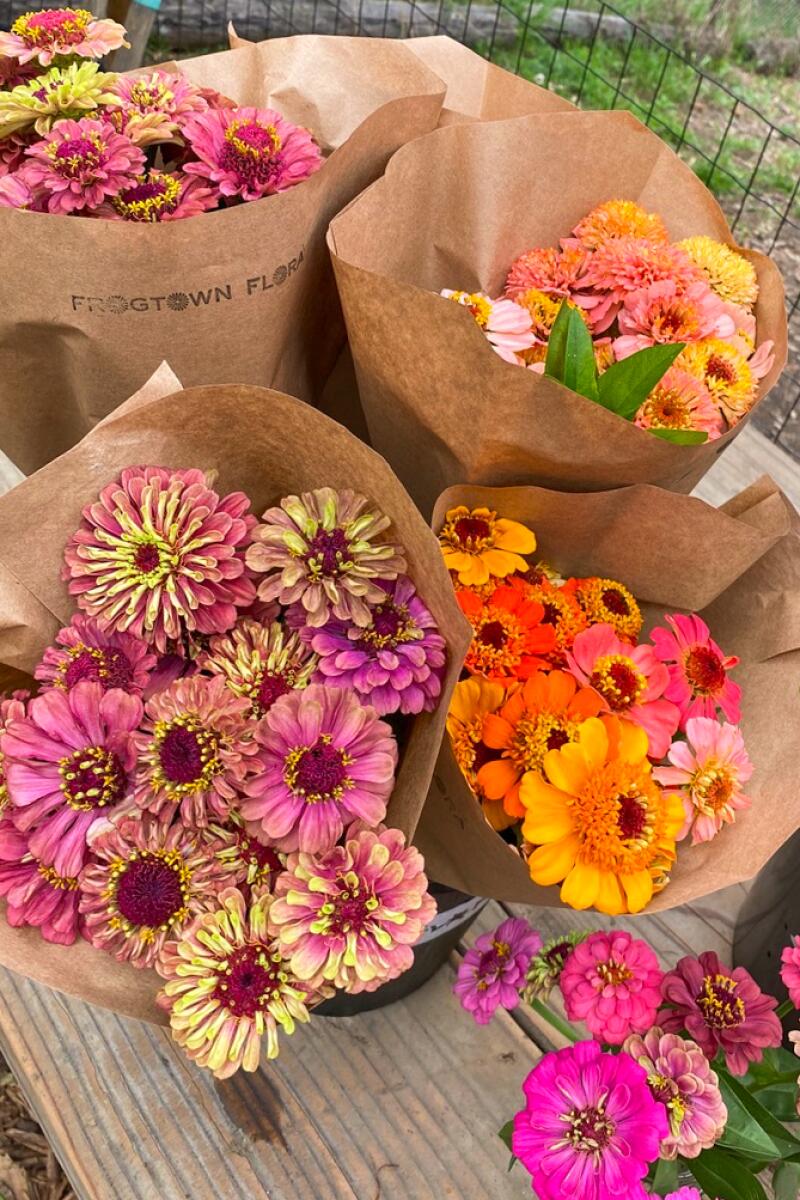
Frogtown Flora bouquets. (Kathleen Ferguson)

Zinnias in Ferguson’s garden. (Christina House / Los Angeles Times)
There’s the feel-good aspect. “It brings so much joy,” she said. “Flowers have been in our culture for as long as humanity. Flowers symbolize so many things. It’s the whole cycle of life. They mean so much to so many different cultures. I love growing. I love the challenge. I also love that I’m making people happy.”
And then there’s the wildlife aspect.
During a recent visit, the contrast between the roar of the nearby 2 Freeway and the sound of birds chatting in the garden was startling. Over in a dense patch of sweet peas, Ferguson pointed out an example of her “nature first” philosophy in the way she strategically cut the flowers to preserve the privacy of a bird’s nest. “The flowers have brought so much additional life to this property,” she said. “I leave that section of sweet peas alone.”
In addition to selling flowers to Kranz and Gather Flora at the Original Los Angeles Flower Market in downtown , Ferguson recently started bouquet subscriptions and organized a tour of eight flower farms in L.A. She expected 50 people to show up. “We had to shut down our reservations when it hit 800,” she said, noting the interest in locally grown flowers.
According to a 2023 National Gardening Assn. Survey, 63% of respondents indicated that locally grown blooms were important when purchasing cut flowers and arrangements, while 59% indicated that blossoms grown in the United States were important when purchasing cut flowers and arrangements.
Like the slow food and slow fashion movements, consumers want to know where their flowers come from, said Debra Prinzing, founder of the Slow Flowers Society.
“I think people want to engage more deeply with nature as an antidote to the general stress and chaos of life,” Prinzing said. “Locally grown flowers, like those from Frogtown Flora and other Southern California flower farmers large and small, provide the sensory connections we crave. They reflect the season, moment in time and location when we commemorate special occasions or everyday gestures.”

Dawn Creek Blush in Ferguson’s garden.

Ferguson smells a rose in her hillside garden.
Ferguson, 55, also sells mixed vase arrangements and buckets of blooms to customers interested in fresh flowers but not necessarily a designed arrangement. “This is a great option for DIY weddings and celebrations and for those who just want beautiful, pesticide-free, fresh and locally grown flowers,” she said.
Walking up to the garden from the street along the long driveway, it’s clear why Musson is delighted with the plot’s transformation.
“Some days, when I’m exhausted, I’ll come up here and see a new flower that I’ve never seen before,” he said. “Sometimes I can’t believe I’m living in L.A. A Target is within walking distance, yet I have mature coastal live oaks, toyon and Catalina cherry trees. There are bats. I hear owls at night…. It’s amazing to have a place for the bees and butterflies to go.”

Lifestyle
What worked — and what didn’t — in the ‘Stranger Things’ finale
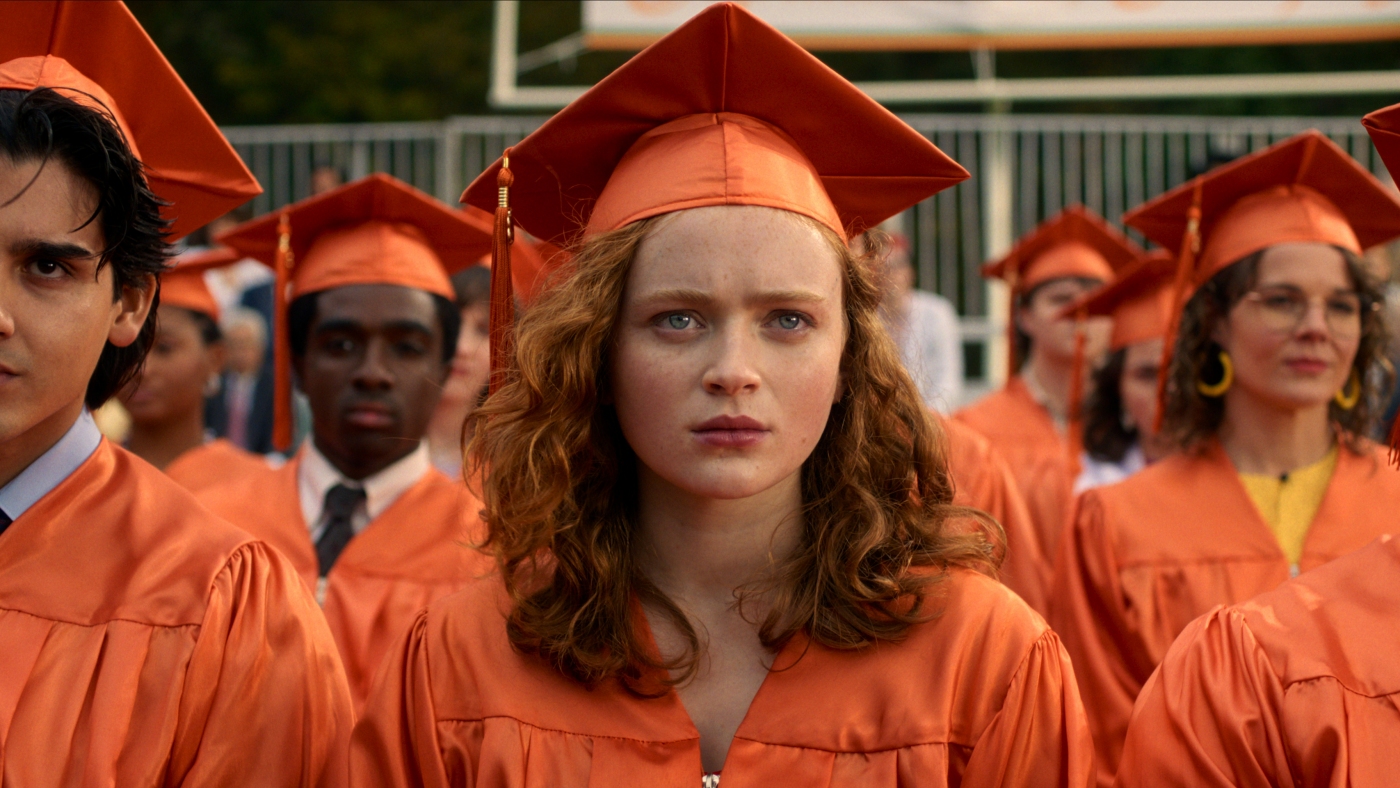
Sadie Sink as Max Mayfield.
Netflix
hide caption
toggle caption
Netflix
Yes, there are spoilers ahead for the final episode of Stranger Things.
On New Year’s Eve, the very popular Netflix show Stranger Things came to an end after five seasons and almost 10 years. With actors who started as tweens now in their 20s, it was probably inevitable that the tale of a bunch of kids who fought monsters would wind down. In the two-plus-hour finale, there was a lot of preparation, then there was a final battle, and then there was a roughly 40-minute epilogue catching up with our heroes 18 months later. And how well did it all work? Let’s talk about it.
Worked: The final battle
The strongest part of the finale was the battle itself, set in the Abyss, in which the crew battled Vecna, who was inside the Mind Flayer, which is, roughly speaking, a giant spider. This meant that inside, Eleven could go one-on-one with Vecna (also known as Henry, or One, or Mr. Whatsit) while outside, her friends used their flamethrowers and guns and flares and slingshots and whatnot to take down the Mind Flayer. (You could tell that Nancy was going to be the badass of the fight as soon as you saw not only her big gun, but also her hair, which strongly evoked Ripley in the Alien movies.) And of course, Joyce took off Vecna’s head with an axe while everybody remembered all the people Vecna has killed who they cared about. Pretty good fight!
Did not work: Too much talking before the fight
As the group prepared to fight Vecna, we watched one scene where the music swelled as Hopper poured out his feelings to Eleven about how she deserved to live and shouldn’t sacrifice herself. Roughly 15 minutes later, the music swelled for a very similarly blocked and shot scene in which Eleven poured out her feelings to Hopper about why she wanted to sacrifice herself. Generally, two monologues are less interesting than a conversation would be. Elsewhere, Jonathan and Steve had a talk that didn’t add much, and Will and Mike had a talk that didn’t add much (after Will’s coming-out scene in the previous episode), both while preparing to fight a giant monster. It’s not that there’s a right or wrong length for a finale like this, but telling us things we already know tends to slow down the action for no reason. Not every dynamic needed a button on it.
Worked: Dungeons & Dragons bringing the group together
It was perhaps inevitable that we would end with a game of D&D, just as we began. But now, these kids are feeling the distance between who they are now and who they were when they used to play together. The fact that they still enjoy each other’s company so much, even when there are no world-shattering stakes, is what makes them seem the most at peace, more than a celebratory graduation. And passing the game off to Holly and her friends, including the now-included Derek, was a very nice touch.

Charlie Heaton as Jonathan Byers, Natalia Dyer as Nancy Wheeler, Maya Hawke as Robin Buckley, and Joe Keery as Steve Harrington.
Netflix
hide caption
toggle caption
Netflix
Did not work: Dr. Kay, played by Linda Hamilton
It seemed very exciting that Stranger Things was going to have Linda Hamilton, actual ’80s action icon, on hand this season playing Dr. Kay, the evil military scientist who wanted to capture and kill Eleven at any cost. But she got very little to do, and the resolution to her story was baffling. After the final battle, after the Upside Down is destroyed, she believes Eleven to be dead. But … then what happened? She let them all call taxis home, including Hopper, who killed a whole bunch of soldiers? Including all the kids who now know all about her and everything she did? All the kids who ventured into the Abyss are going to be left alone? Perfect logic is certainly not anybody’s expectation, but when you end a sequence with your entire group of heroes at the mercy of a band of violent goons, it would be nice to say something about how they ended up not at the mercy of said goons.
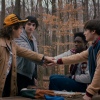

Worked: Needle drops
Listen, it’s not easy to get one Prince song for your show, let alone two: “Purple Rain” and “When Doves Cry.” When the Duffer Brothers say they needed something epic, and these songs feel epic, they are not wrong. There continues to be a heft to the Purple Rain album that helps to lend some heft to a story like this, particularly given the period setting. “Landslide” was a little cheesy as the lead-in to the epilogue, but … the epilogue was honestly pretty cheesy, so perhaps that’s appropriate.
Did not work: The non-ending
As to whether Eleven really died or is really just backpacking in a foreign country where no one can find her, the Duffer Brothers, who created the show, have been very clear that the ending is left up to you. You can think she’s dead, or you can think she’s alive; they have intentionally not given the answer. It’s possible to write ambiguous endings that work really well, but this one felt like a cop-out, an attempt to have it both ways. There’s also a real danger in expanding characters’ supernatural powers to the point where they can make anything seem like anything, so maybe much of what you saw never happened. After all, if you don’t know that did happen, how much else might not have happened?
This piece also appears in NPR’s Pop Culture Happy Hour newsletter. Sign up for the newsletter so you don’t miss the next one, plus get weekly recommendations about what’s making us happy.
Listen to Pop Culture Happy Hour on Apple Podcasts and Spotify.
Lifestyle
The Best of BoF 2025: Conglomerates, Controversy and Consolidation

Lifestyle
Sunday Puzzle: P-A-R-T-Y words and names

On-air challenge
Today I’ve brought a game of ‘Categories’ based on the word “party.” For each category I give, you tell me something in it starting with each of the letters, P-A-R-T-Y. For example, if the category were “Four-Letter Boys’ Names” you might say Paul, Adam, Ross, Tony, and Yuri. Any answer that works is OK, and you can give answers in any order.
1. Colors
2. Major League Baseball Teams
3. Foreign Rivers
4. Foods for a Thanksgiving Meal
Last week’s challenge
I was at a library. On the shelf was a volume whose spine said “OUT TO SEA.” When I opened the volume, I found the contents has nothing to do with sailing or the sea in any sense. It wasn’t a book of fiction either. What was in the volume?
Challenge answer
It was a volume of an encyclopedia with entries from OUT- to SEA-.
Winner
Mark Karp of Marlboro Township, N.J.
This week’s challenge
This week’s challenge comes from Joseph Young, of St. Cloud, Minn. Think of a two-syllable word in four letters. Add two letters in front and one letter behind to make a one-syllable word in seven letters. What words are these?
If you know the answer to the challenge, submit it below by Wednesday, December 31 at 3 p.m. ET. Listeners whose answers are selected win a chance to play the on-air puzzle.
-

 Entertainment1 week ago
Entertainment1 week agoHow the Grinch went from a Yuletide bit player to a Christmas A-lister
-

 Connecticut1 week ago
Connecticut1 week agoSnow Accumulation Estimates Increase For CT: Here Are The County-By-County Projections
-

 World6 days ago
World6 days agoHamas builds new terror regime in Gaza, recruiting teens amid problematic election
-

 Indianapolis, IN1 week ago
Indianapolis, IN1 week agoIndianapolis Colts playoffs: Updated elimination scenario, AFC standings, playoff picture for Week 17
-

 Southeast1 week ago
Southeast1 week agoTwo attorneys vanish during Florida fishing trip as ‘heartbroken’ wife pleads for help finding them
-

 Business1 week ago
Business1 week agoGoogle is at last letting users swap out embarrassing Gmail addresses without losing their data
-

 World1 week ago
World1 week agoSnoop Dogg, Lainey Wilson, Huntr/x and Andrea Bocelli Deliver Christmas-Themed Halftime Show for Netflix’s NFL Lions-Vikings Telecast
-

 World1 week ago
World1 week agoBest of 2025: Top five defining moments in the European Parliament
